MS Alumni
Ayush Sharma, ReSupply, CAS ’25
 Originally from Jhansi, India, Ayush graduated from the MS in AI program in May 2025. With a strong foundation in mathematics and computer science, he became interested in machine learning during his undergraduate studies and decided to pursue advanced training in AI. Before coming to BU, he worked as a Machine Learning Intern at Schneider Electric, gaining practical industry experience.
Originally from Jhansi, India, Ayush graduated from the MS in AI program in May 2025. With a strong foundation in mathematics and computer science, he became interested in machine learning during his undergraduate studies and decided to pursue advanced training in AI. Before coming to BU, he worked as a Machine Learning Intern at Schneider Electric, gaining practical industry experience.
At BU, Ayush chose the specialized AI program for its focus on the intersection of math, logic, and applied computing. He contributed to the academic community as a Teaching Assistant, Research Assistant, and through his Master’s thesis, while also taking advantage of BU’s resources such as the Computing & Data Sciences building and FitRec. He describes his experience as defined by diversity, academic rigor, and valuable professional exposure.
Following graduation, Ayush accepted a position as an AI Engineer at ReSupply, a company based in Downtown Boston. In this role, he will build on his academic and research background to develop applied AI solutions.
Read and interview with Ayush here.
Thomas Liu, CAS ’25
 Thomas Liu is a graduate student in Computer Science at Boston University’s Graduate School of Arts & Sciences. He chose BU for its strong academic reputation, diverse student community, and the opportunities created by Boston’s thriving tech ecosystem and interdisciplinary approach.
Thomas Liu is a graduate student in Computer Science at Boston University’s Graduate School of Arts & Sciences. He chose BU for its strong academic reputation, diverse student community, and the opportunities created by Boston’s thriving tech ecosystem and interdisciplinary approach.
During his time at BU, Thomas has appreciated the collaborative culture and the exchange of perspectives in the classroom. He often spends time at the George Sherman Union for studying or relaxing, and at the Center for Computing & Data Sciences, where he enjoys the modern study spaces and classrooms. He also values Boston’s cultural diversity and the chance to meet people from around the world, whether on campus or along the Charles River.
After graduation, Thomas plans to pursue a career in the tech industry, with interests in data science, AI, and software engineering.
Sarah Taaher Bonna, TikTok, GRS ’23
 After graduating with her Master’s in Computer Science in 2o23, Sarah joined TikTok as a Backend Software Engineer. Prior to starting her graduate studies, she completed her undergraduate studies in Computer Engineering at the National University of Singapore and chose BU to gain research experience, deepen her knowledge in computer science, and study in Boston’s dynamic academic environment with access to world-class faculty.
After graduating with her Master’s in Computer Science in 2o23, Sarah joined TikTok as a Backend Software Engineer. Prior to starting her graduate studies, she completed her undergraduate studies in Computer Engineering at the National University of Singapore and chose BU to gain research experience, deepen her knowledge in computer science, and study in Boston’s dynamic academic environment with access to world-class faculty.
On campus, Sarah’s favorite places include the Ziskind Lounge at the George Sherman Union, BU Beach, and the CAS Think Tank. She has especially valued meeting peers from diverse backgrounds and learning from their experiences, both inside and outside the classroom. Studying in the U.S. has also given her the chance to experience all four seasons for the first time, from colorful fall foliage to snow in winter and blooming flowers in spring—an entirely new perspective after growing up in a tropical climate.
Outside academics, Sarah enjoys exploring Boston’s parks such as Back Bay Fens, Boston Common, and the Public Garden, as well as trying new restaurants and bubble tea spots.
Abhishek Malakar, OpenGov, GRS ’23
 Abhishek began working at the financial start-up OpenGov as a Software Engineer upon graduation with his Masters of Computer Science. Although originally from Kolkata, he spent most of his life in Mumbai, India, and completed his undergraduate studies in Electronics and Communications at the Manipal Institute of Technology. Before joining BU, he worked as a software developer at Standard Chartered GBS in Bangalore, India, for over a year.
Abhishek began working at the financial start-up OpenGov as a Software Engineer upon graduation with his Masters of Computer Science. Although originally from Kolkata, he spent most of his life in Mumbai, India, and completed his undergraduate studies in Electronics and Communications at the Manipal Institute of Technology. Before joining BU, he worked as a software developer at Standard Chartered GBS in Bangalore, India, for over a year.
Abhishek chose BU for its strong computer science program, interdisciplinary opportunities, and access to world-class faculty. He has appreciated the approachable professors and teaching assistants, whose office hours allow for meaningful discussion and research guidance. His favorite spots on campus include BU Beach along the Esplanade walkway next to the Charles River, where he enjoys reflection and relaxation, and the BUild Labs, which host innovative talks on entrepreneurship and technology.
Life in Boston has been welcoming and vibrant, with convenient public transportation and diverse neighborhoods like Seaport, Fenway Park, and the Public Garden. After graduation,
Aditya Pal, ASML, GRS ’22
 Aditya joined the Dutch company ASML as a Software Engineer after graduating with his MS in Computer Science. He is from New Delhi, India, and completed his undergraduate degree in computer science before working as a software engineer at Ford Motor Company’s Global Technology & Business Center in Chennai, India.
Aditya joined the Dutch company ASML as a Software Engineer after graduating with his MS in Computer Science. He is from New Delhi, India, and completed his undergraduate degree in computer science before working as a software engineer at Ford Motor Company’s Global Technology & Business Center in Chennai, India.
Aditya chose BU for its strong computer science curriculum, exceptional faculty, and research opportunities. He appreciates the university’s open city campus, which combines the energy of Boston with scenic lawns and outdoor spaces. On campus, his favorite spots include BU FitRec, where he enjoys fitness and recreation, BU Beach overlooking the Charles River, and the BUild Lab for group projects and study sessions.
He values the welcoming environment at BU, especially the accessibility of professors through office hours, which has greatly enhanced his learning experience. Life in Boston has offered him both a vibrant city atmosphere and peaceful outdoor spaces for relaxation and exploration.
BA & BA/MS Alumni
Jacqueline Belkin, BAE Systems, Inc., CAS ’04
 Jacqueline Belkin (CAS ’04) says her job with BAE Systems, Inc.—an electronics manufacturer that develops advanced defense and aerospace systems in the air, land, sea, and space—is doubly rewarding. While she oversees the organization and management of the company’s software, ensuring product integrity and customer satisfaction, her efforts ultimately serve a greater purpose: making the world a safer place.”I am proud to contribute to the building of technical systems for the U.S. Department of Defense,” says Belkin, a software configuration manager. “It is very rewarding to know that I play a part in protecting our troops in combat and ultimately in protecting Americans from harm.”
Jacqueline Belkin (CAS ’04) says her job with BAE Systems, Inc.—an electronics manufacturer that develops advanced defense and aerospace systems in the air, land, sea, and space—is doubly rewarding. While she oversees the organization and management of the company’s software, ensuring product integrity and customer satisfaction, her efforts ultimately serve a greater purpose: making the world a safer place.”I am proud to contribute to the building of technical systems for the U.S. Department of Defense,” says Belkin, a software configuration manager. “It is very rewarding to know that I play a part in protecting our troops in combat and ultimately in protecting Americans from harm.”
A female math teacher interested in recruiting women into the technical field first encouraged Belkin to take an advanced placement (AP) computer science class in high school. “I took that AP class and never looked back,” Belkin says, “and the courses at BU strengthened my desire to enter the computer science field.”
Belkin, who graduated summa cum laude from BU, says the openness and availability of the computer science faculty made a huge impact. “I would attend the office hours of many of my professors for extra assistance, and each was easy to approach and more than willing to lend some help,” she says. At BU, Belkin also minored in Judaic Studies, was an active member of the Hillel House, and served as president, treasurer, and secretary of Boston University Students for Israel (BUSI).
Belkin says the group assignments she completed as an undergraduate in the Computer Science Department influenced her professional career immensely. “I had to learn to work effectively with a variety of students. I am successful at my job today because I am able to work with any and all types of people,” she says. “I am able to check my ego at the door and work as a true team player.”
Greg Fletcher, Akamai Technologies, CAS/SMG’00, GRS ’03
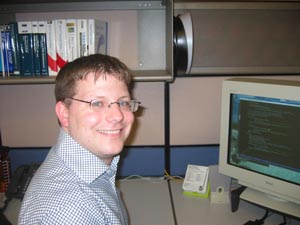 To say that Greg Fletcher’s (CAS/SMG’00, GRS ’03) contribution to Akamai Technologies is far reaching would be an understatement. Software he has written is running on 15,000 servers deployed in over 1,000 networks across 65 countries. Today, as a senior software engineer, Fletcher is leading Akamai’s engineering effort for a new set of products for IP application acceleration. His objective: to improve the performance and reliability of IP-based applications using Akamai’s globally distributed computing platform.It was an introductory computer science course at BU that originally captivated Fletcher’s interest in the field. “I was hooked,” he says. “It just fit. I really enjoyed the challenges and analytical problem solving required in both the theoretical and systems side of the science.” Hooked and ambitious, Fletcher not only double majored in computer science and business administration and management, but also pursued a master’s degree in computer science at BU, where he researched the indexing of spatiotemporal databases.
To say that Greg Fletcher’s (CAS/SMG’00, GRS ’03) contribution to Akamai Technologies is far reaching would be an understatement. Software he has written is running on 15,000 servers deployed in over 1,000 networks across 65 countries. Today, as a senior software engineer, Fletcher is leading Akamai’s engineering effort for a new set of products for IP application acceleration. His objective: to improve the performance and reliability of IP-based applications using Akamai’s globally distributed computing platform.It was an introductory computer science course at BU that originally captivated Fletcher’s interest in the field. “I was hooked,” he says. “It just fit. I really enjoyed the challenges and analytical problem solving required in both the theoretical and systems side of the science.” Hooked and ambitious, Fletcher not only double majored in computer science and business administration and management, but also pursued a master’s degree in computer science at BU, where he researched the indexing of spatiotemporal databases.
As an undergraduate, Fletcher worked in the department’s computer lab before he was promoted to the user services group. He also recalls a popular networking course that he found particularly rewarding. “It influenced me to be in a position with a networking company like the one I’m in today,” he says. “The projects were difficult and intellectually rewarding, and the concepts were interesting.”
Fletcher first learned of Akamai, a leading global service for distributing online content and business processes, through a professor from BU’s Computer Science Department who also worked for the company as a systems architect. “I have no regrets,” Fletcher says. “I’m quite happy with my job. I enjoy solving tough networking problems and finding solutions that have value to the business.”
“My education at BU gave me the confidence to address hard problems in a highly intelligent environment,” he adds. “Whether the topic is complexity, concurrency, caching, or congestion control, I can propose and defend solutions confidently.”
Kevin Harmon, Akamai Technologies, CAS/GRS’05
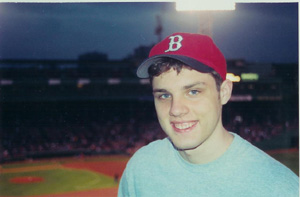 Kevin Harmon (CAS/GRS ’05), a software engineer for Akamai Technologies—a leading global service for distributing online content and business processes— couldn’t be happier with his first job after graduating from BU. “I really enjoy what I’m doing right now,” he says, “and I can’t see wanting to change that any time soon.”Headquartered in Cambridge, Massachusetts, Akamai “delivers roughly 10 to 20 percent of all traffic on the Web, with the goal of improving performance and reliability,” Harmon explains. “Many businesses and government agencies rely on Akamai to make sure Web content and applications work without delays or interruptions.”
Kevin Harmon (CAS/GRS ’05), a software engineer for Akamai Technologies—a leading global service for distributing online content and business processes— couldn’t be happier with his first job after graduating from BU. “I really enjoy what I’m doing right now,” he says, “and I can’t see wanting to change that any time soon.”Headquartered in Cambridge, Massachusetts, Akamai “delivers roughly 10 to 20 percent of all traffic on the Web, with the goal of improving performance and reliability,” Harmon explains. “Many businesses and government agencies rely on Akamai to make sure Web content and applications work without delays or interruptions.”
As part of Akamai’s Federal Engineering and Custom Solutions group, Harmon helps with the design, implementation, and testing of Akamai’s software, and his particular project uses route optimization to find the best path across the Internet and ultimately improve performance. “It’s particularly rewarding to be on the cutting edge of technology, and to see my work have an immediate and large impact on the way the Internet works,” he says.
During his junior year at BU, Harmon was accepted into a special program offered by the Computer Science Department for a BA/MA, a joint degree students can earn in four and a half years after completing graduate course work and a master’s project in addition to the standard BA requirements. Harmon’s master’s project was the first application to implement a method for efficiently decoding a type of error-correcting code called a BCH code, a method he used to perform private and secure information reconciliation.
The variety of computer science courses offered at BU, Harmon says, really made an impact on him. “Being exposed to all the diverse areas of computer science gave me a full and well-rounded perspective of the subject,” he says. “The program provided me with the theoretical and mathematical background and intuition to be able to reason through the process of solving new problems.”
Diane Hirsh Theriault, BAE Systems, CAS’04
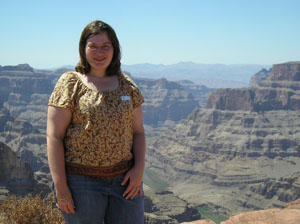 “I think the drive that made me want to program is the same drive that made earlier scientists tinker with machines and electricity,” says Diane Hirsh Theriault (CAS’04), a software engineer with the Advanced Information Technologies (AIT) division of BAE Systems, Inc., in Burlington, Massachusetts, which provides advanced technologies and software solutions for the development of U.S. national security.
“I think the drive that made me want to program is the same drive that made earlier scientists tinker with machines and electricity,” says Diane Hirsh Theriault (CAS’04), a software engineer with the Advanced Information Technologies (AIT) division of BAE Systems, Inc., in Burlington, Massachusetts, which provides advanced technologies and software solutions for the development of U.S. national security.
Theriault, who minored in the visual arts (painting and drawing) at BU, appreciates the creative side of computer science. “It’s fun to build things and make things work,” she says. “I feel that programming is an expressive, artistic medium. The fundamentals of computer science give you the skills to wield the medium effectively.” And it was Associate Professor Margrit Betke, she says, who was “instrumental in helping me develop confidence in my ability to do research.”
Theriault explains her undergraduate project at BU, under the guidance of Professors Betke and Tom Kunz, as using “computer vision to analyze infrared thermal video to census Brazilian free-tail bats,” a project she pursued even after graduation through fieldwork in Texas, where she “focused on writing a tracker to better estimate the number of bats observed through an entire sequence.”
After graduating from BU and spending two years at MIT’s Media Laboratory, Theriault earned a master’s degree in media arts and sciences. It was the “vivarium project” in Professor Stan Sclaroff’s computer graphics course at BU-which involved programming a two-dimensional environment with digitally animated creatures that interacted with one another-that ultimately served as a foundation for her graduate thesis at MIT.
Today, at BAE Systems, Theriault works in AIT’s computer vision group. “Right now, I’m working on several programs developing and deploying video exploitation tools, such as target identification, tracking, and video mosaicing on different UAVs [unmanned area vehicles] for the army and air force,” she says. “We do state-of-the-art, cutting-edge applied computer vision research.”
Dan Kirshenbaum, BU Medical School, CAS/GRS’07
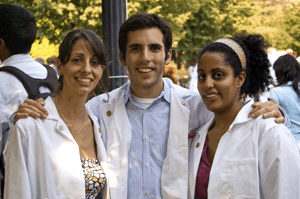 Dan Kirshenbaum (CAS’07) knew he wanted to be a doctor. On the pre-med path at BU, he did all the right things: he minored in biology and was accepted into the prestigious MMEDIC (Modular Medical Integrated Curriculum) program. But when it came time to declare a major, the most common choices-biology, chemistry-left him wanting more. Beyond fulfilling the basic pre-med requirements, Kirshenbaum strayed from the pack, determined to pursue a course of study that would complement his career and enrich his life. After taking CS111, an introductory computer science course, he found the perfect fit. “It turned out that I absolutely loved computer science,” he says. “Computers are becoming more and more integral in the practice of medicine.” Today, Kirshenbaum is a student in the BU School of Medicine (BUSM), where his rare background in computer science and medicine enables him to contribute to the field in unique ways. “It is rewarding to know that the skills I learned as a computer science major at BU are immediately applicable in school and in the clinic,” he says. “Having a background that gives me the ability to think through problems logically makes it much easier to learn the processes of the human body and to apply that knowledge.” Outside of school, he is both a medical student and a programmer at the Center for Neurological Imaging at Brigham and Women’s Hospital in Boston, where he has dedicated a few semesters to interact with patients and develop an application called SPINE (Structured Planning and Implementation of Neuroimaging Experiments). SPINE, he explains, will allow for real-time statistical analysis of the vast database of MRIs accessible to the hospital. Kirshenbaum’s next goal is to establish a subspecialty in a specific field of medicine. “My current leanings are toward neurosurgery and neurology,” he says. “I’m positive that my love of the brain is directly connected to my interest in computers and the theory behind them.” Wherever his path in medicine may lead, Kirshenbaum says computer science is bound to play a role: “Having both skills will hopefully help me make a significant impact on the medical field.”
Dan Kirshenbaum (CAS’07) knew he wanted to be a doctor. On the pre-med path at BU, he did all the right things: he minored in biology and was accepted into the prestigious MMEDIC (Modular Medical Integrated Curriculum) program. But when it came time to declare a major, the most common choices-biology, chemistry-left him wanting more. Beyond fulfilling the basic pre-med requirements, Kirshenbaum strayed from the pack, determined to pursue a course of study that would complement his career and enrich his life. After taking CS111, an introductory computer science course, he found the perfect fit. “It turned out that I absolutely loved computer science,” he says. “Computers are becoming more and more integral in the practice of medicine.” Today, Kirshenbaum is a student in the BU School of Medicine (BUSM), where his rare background in computer science and medicine enables him to contribute to the field in unique ways. “It is rewarding to know that the skills I learned as a computer science major at BU are immediately applicable in school and in the clinic,” he says. “Having a background that gives me the ability to think through problems logically makes it much easier to learn the processes of the human body and to apply that knowledge.” Outside of school, he is both a medical student and a programmer at the Center for Neurological Imaging at Brigham and Women’s Hospital in Boston, where he has dedicated a few semesters to interact with patients and develop an application called SPINE (Structured Planning and Implementation of Neuroimaging Experiments). SPINE, he explains, will allow for real-time statistical analysis of the vast database of MRIs accessible to the hospital. Kirshenbaum’s next goal is to establish a subspecialty in a specific field of medicine. “My current leanings are toward neurosurgery and neurology,” he says. “I’m positive that my love of the brain is directly connected to my interest in computers and the theory behind them.” Wherever his path in medicine may lead, Kirshenbaum says computer science is bound to play a role: “Having both skills will hopefully help me make a significant impact on the medical field.”
Kevin Law, Google, CAS’05
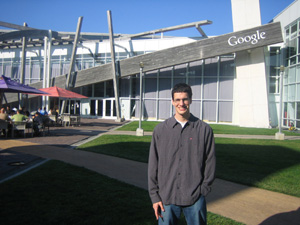 Interested in programming and computer graphics since high school, Kevin Law (CAS’05) knew early on that he wanted to major in computer science. But only after meeting professors in the Computer Science Department at BU—many of whom would play an influential role in his academic career—did Law know where all of his interests would take him.Now a software engineer for Google in Mountain View, California, Law says BU’s Computer Science Department appealed to him because of the exposure it offered to so many different areas in the field, such as computer vision, graphics, and artificial intelligence. Once he started taking more advanced computer science classes at the university, Law says, “I decided I made the right decision.”
Interested in programming and computer graphics since high school, Kevin Law (CAS’05) knew early on that he wanted to major in computer science. But only after meeting professors in the Computer Science Department at BU—many of whom would play an influential role in his academic career—did Law know where all of his interests would take him.Now a software engineer for Google in Mountain View, California, Law says BU’s Computer Science Department appealed to him because of the exposure it offered to so many different areas in the field, such as computer vision, graphics, and artificial intelligence. Once he started taking more advanced computer science classes at the university, Law says, “I decided I made the right decision.”
Law also took advantage of the many electives offered outside of his major, enrolling in courses like French, German, and Greek and Roman history, and even played in BU’s intramural hockey league for four years—but nothing could prepare him for a career in computer science like the hands-on experience he gained through the department.
At BU, Law participated in the Image and Video Computing Group, which is developing systems to determine what a computer “sees” or “recognizes.” Without this experience, Law says, he never could have interned with a robotics research company in Maryland or worked for a company like Google, where he now applies his skills to the company’s image search team.
Google’s mission, Law explains, is to “organize all of the world’s information and make it accessible to everyone. We attempt to get as many images from the Web as possible and allow people to search them,” he adds. Law also says he’s excited about a new opportunity, applying computer vision techniques to image searching, and how it could revolutionize the field. “That technology is in a primitive phase,” he says, “so there’s a lot of really interesting work to do over the next few years.”
Amy Lenarz, Microgistix, CAS’03
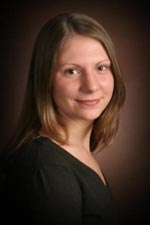 Amy Lenarz (CAS’03) is fascinated by software project management, and, like any good software engineer, she never shies away from a challenge. “We’ve all seen software companies miss deadlines for releasing new products,” she says. Because of the creativity involved in software development, Lenarz explains, “the process can be very unpredictable and difficult to manage. There’s no formula for it. It’s that complexity, that difficulty in predicting what it will take to get a project done, that really interests me.”And Lenarz is well on her way to making her mark in the industry. After majoring in computer science at BU, she moved back to her hometown near Edina, Minnesota, working as a software engineer for ZEMNOTT, which develops entertainment, educational, and custom business software. With ZEMNOTT, Lenarz says she was able to work on “games that I had played as a kid and that my friends had heard of,” like, “Where in the World is Carmen Sandiego?”
Amy Lenarz (CAS’03) is fascinated by software project management, and, like any good software engineer, she never shies away from a challenge. “We’ve all seen software companies miss deadlines for releasing new products,” she says. Because of the creativity involved in software development, Lenarz explains, “the process can be very unpredictable and difficult to manage. There’s no formula for it. It’s that complexity, that difficulty in predicting what it will take to get a project done, that really interests me.”And Lenarz is well on her way to making her mark in the industry. After majoring in computer science at BU, she moved back to her hometown near Edina, Minnesota, working as a software engineer for ZEMNOTT, which develops entertainment, educational, and custom business software. With ZEMNOTT, Lenarz says she was able to work on “games that I had played as a kid and that my friends had heard of,” like, “Where in the World is Carmen Sandiego?”
Now a back office systems architect in Minneapolis for Microgistix, a liaison between software publishers and outlets, Lenarz develops e-commerce Web sites for the company, maintains its database, creates reporting tools for its sales and management teams, and manages its Electronic Data Interchange (EDI) relationships with customers and vendors.
Despite her success with computer science, Lenarz admits her heart was once set on biology, but a summer spent interning with the USDA Forest Service ultimately changed her mind. “I realized I had been spending the entire summer excited to get back to my computer science classes,” Lenarz says, and she proceeded to change her major.
Today, Lenarz says her computer science degree has given her a solid foundation, setting her apart in the work force. “My first employer liked that I had specific experience with database development and network protocols,” she says, “but I think what really made me valuable was that I had such a wide range of experience from the wide variety of computer science classes I had taken at BU.”
Ryan Mahon, U.S. Department of Defense, CAS’03
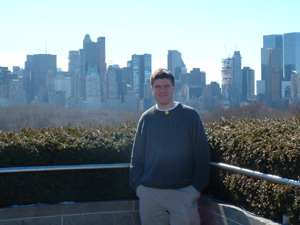 The Internet and its technologies exploded in the early 1990s, and with it, says Ryan Mahon (CAS’03), an illusion of safety for its users. Security was unfortunately an afterthought. As debilitating worms and viruses plagued the network, causing the failure of computers all over the world, the need for secure software development was never more evident. And as dependency on Internet technology continues to grow today, so does the risk of new worms and viruses.”I believe that every piece of complicated software has at least a few vulnerabilities that can be exploited by a clever hacker,” Mahon says. “Designing ways to detect and prevent these attacks against vulnerable software, without even knowing how the attack will come, is the challenge of information/network security.”
The Internet and its technologies exploded in the early 1990s, and with it, says Ryan Mahon (CAS’03), an illusion of safety for its users. Security was unfortunately an afterthought. As debilitating worms and viruses plagued the network, causing the failure of computers all over the world, the need for secure software development was never more evident. And as dependency on Internet technology continues to grow today, so does the risk of new worms and viruses.”I believe that every piece of complicated software has at least a few vulnerabilities that can be exploited by a clever hacker,” Mahon says. “Designing ways to detect and prevent these attacks against vulnerable software, without even knowing how the attack will come, is the challenge of information/network security.”
Mahon welcomed this challenge with enthusiasm as a student at BU. Courses like Algorithmic Aspects of Computer Networks, Networking, Cryptography, and System Fundamentals not only sparked his interest in networking and security, but also encouraged him, he says, to pursue a master’s degree in Information Security Technology and Management at Carnegie Mellon University, which he earned in May 2005.
At BU, Mahon graduated from the CAS Honors Program, delivered the graduation speech to his peers in May 2003, and completed a Work of Distinction on “Dynamic Environments Linked by Virtual Vicinity,” along with several research projects associated with his course work. His graduate research involved privacy in instant message communication, which complemented his undergraduate studies of peer-to-peer networks, widely used today to share and transfer media like movies and music, but not without its own security limitations.
Mahon now puts all of his talents to work for the U.S. Department of Defense in Washington, D.C., as an analyst. “It’s rewarding to go into work each day and know you’re doing something to help the country,” he says. “The work itself is challenging, but my education at BU and CMU has more than prepared me.”
Lourdes Martinez, Raytheon, CAS’01
 Lourdes Martinez (CAS’01) is living proof of just how far one can go with a degree in computer science. Impassioned by the field of software development and its impact across so many disciplines, Martinez calls computer science the “new liberal arts of the technology age.” “You can take this degree in a lot of different directions,” she says. “A major part of me is very technically oriented. I’m also very creative, and I wanted a degree that would allow me to be both.”After graduating from BU, Martinez set her sights on Raytheon, an industry leader in defense and aerospace mission systems integration. As a member of the Raytheon Advanced Prototyping, Integration and Demonstration (RAPID) Lab, Martinez investigated emerging software technologies. In less than two years on the job, she won Best Presentation Award at a Raytheon-wide systems and software symposium for her presentation related to model-driven development.
Lourdes Martinez (CAS’01) is living proof of just how far one can go with a degree in computer science. Impassioned by the field of software development and its impact across so many disciplines, Martinez calls computer science the “new liberal arts of the technology age.” “You can take this degree in a lot of different directions,” she says. “A major part of me is very technically oriented. I’m also very creative, and I wanted a degree that would allow me to be both.”After graduating from BU, Martinez set her sights on Raytheon, an industry leader in defense and aerospace mission systems integration. As a member of the Raytheon Advanced Prototyping, Integration and Demonstration (RAPID) Lab, Martinez investigated emerging software technologies. In less than two years on the job, she won Best Presentation Award at a Raytheon-wide systems and software symposium for her presentation related to model-driven development.
Martinez says BU played an integral role when she was considered for one of her most recent accolades. With the support and recommendation of her academic adviser, Martinez was named Most Promising Engineer of 2004 by the Hispanic Engineer National Achievement Award Corporation (HENAAC).
When Martinez was offered a position with Raytheon’s DD(X) Program in Tewksbury, Massachusetts, as a member of its Total Ship Computing Environment (TSCE) Infrastructure software architecture team, she readily accepted. In May 2005, Raytheon secured a $3 billion contract with the U.S. Navy to implement the TSCE, which gives the warfighter many technical advantages; Raytheon describes it as a system that “allows the Navy to integrate all shipboard warfighting and peacetime operations into a common, interoperable enterprise-like computing environment.”
Martinez credits the Computer Science Department at BU for equipping her with a “core set of competencies” essential in today’s job market, and says nothing can surpass just loving what you do. “It’s really important in your academic and professional pursuits to have passion for your work,” she says. “That’s the key ingredient in making yourself successful.”
Kyle Olszewski, Georgia Institute of Technology, CAS’07
 A love of video games and animated movies naturally led Kyle Olszewski to BU, where he earned both a BA in computer science and a BS in film and television through the Boston University Collaborative Degree Program. BUCOP enables undergraduate students to enroll in two of the university’s schools or colleges and earn two baccalaureate degrees simultaneously.
A love of video games and animated movies naturally led Kyle Olszewski to BU, where he earned both a BA in computer science and a BS in film and television through the Boston University Collaborative Degree Program. BUCOP enables undergraduate students to enroll in two of the university’s schools or colleges and earn two baccalaureate degrees simultaneously.
For Olszewski, who took a few basic computer-programming classes in high school, studying the history of cinema and the artistry of filmmaking led to a greater fascination with the “technical details of film development, such as how cameras and lenses actually work, and the algorithms used for digital video and audio editing.”
While he was writing, producing, directing, and editing several short films, he was also discovering the fundamentals of computer graphics in the Computer Science Department—creating a user-controlled model of the human hand, programming a three-dimensional environment “filled with creatures that interacted with one another,” and writing a ray-tracing program to produce “realistic-looking effects such as reflections and refractions in shiny and translucent objects.”
Today, Olszewski is pursuing a master’s degree in computer science at Georgia Tech, where he’s focusing on computer graphics and animation and high-performance computing. He also spent three months interning as a software engineer in Silicon Valley with NVIDIA—a world leader in visual computing technologies and manufacturer of computer graphics processors—where he hopes to return full time after graduating.
At NVIDIA, Olszewski was part of the OpenGL driver group, which develops software for professional workstations, and combined his love for digital animation with the technical skills that make it all possible. “It’s rewarding to know that the software you worked on will be used by literally millions of people around the world in diverse areas,” he says, “ranging from playing and developing video games to designing new aircraft and creating and animating scenes in movies.”
Michelle Paquette, Fidelity Investments, CAS’03, GRS’05
 Michelle Paquette (CAS’03, GRS’05) realized early on that a degree in computer science would take her above and beyond her highest expectations. As a graduate student in BU’s Computer Science Department, she worked on the innovative IWebExplorer browser—designed for use with an eye controlled mouse device—and focused on developing video-based human-computer interfaces to make certain technologies accessible to the disabled.Paquette put the computer vision skills she learned at BU to the test during a visit to The Boston Home, which offers long-term health care for physically disabled adults. “I felt extremely proud when I saw the excitement from the residents at the thought of being able to surf the Internet without having to use a mouse,” Paquette says. “I understood then that even I could create something that could affect the lives of so many people.”
Michelle Paquette (CAS’03, GRS’05) realized early on that a degree in computer science would take her above and beyond her highest expectations. As a graduate student in BU’s Computer Science Department, she worked on the innovative IWebExplorer browser—designed for use with an eye controlled mouse device—and focused on developing video-based human-computer interfaces to make certain technologies accessible to the disabled.Paquette put the computer vision skills she learned at BU to the test during a visit to The Boston Home, which offers long-term health care for physically disabled adults. “I felt extremely proud when I saw the excitement from the residents at the thought of being able to surf the Internet without having to use a mouse,” Paquette says. “I understood then that even I could create something that could affect the lives of so many people.”
As an undergraduate, Paquette worked with the Polymer Studies Group in the Physics Department at BU to develop educational software. She was then given a full scholarship to attend graduate school at BU by the National Science Foundation, which sponsored the GK12 program at Chelsea High School where Paquette worked with a teacher as a fellow.
Now a full-time software engineer/developer for Fidelity Investments, Fidelity Brokerage Company Technology in Boston, Paquette says she owes a great deal of her success to her role as a student ambassador for Microsoft. “I was able to improve my public speaking skills, increase my network, and keep up with the latest technologies,” she says. In 2005, Microsoft selected Paquette as a lead student ambassador, one of only sixteen in the country.
Paquette says she was drawn to BU’s Computer Science Department because of the renowned faculty and individualized attention afforded to students. “I liked the fact that it was smaller,” she says of the department, “and there was more personal interaction with the professors. Our classes were never over-sized, and my professors always had time to meet with me whenever I needed help.”
Chekema Prince, NYU School of Medicine, CAS’02
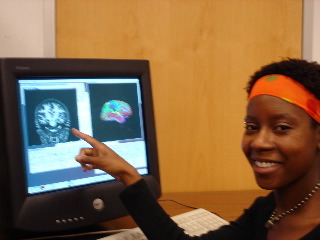 Chekema Prince (CAS’02) is using her background in computer science to help radiologists diagnose diseases like cancer, Alzheimer’s, and Parkinson’s through magnetic resonance imaging (MRI) technology, and is witnessing firsthand how the early detection of such diseases can lead to more effective treatments for patients.Prince participated in BU’s Undergraduate Research Opportunities Program (UROP), working to detect lung nodules in consecutive CT scans to access their growth and change. This experience, along with courses like Computer Vision and her involvement in the Imaging and Video Computing Group, developed into an in-depth study of MRI applications.
Chekema Prince (CAS’02) is using her background in computer science to help radiologists diagnose diseases like cancer, Alzheimer’s, and Parkinson’s through magnetic resonance imaging (MRI) technology, and is witnessing firsthand how the early detection of such diseases can lead to more effective treatments for patients.Prince participated in BU’s Undergraduate Research Opportunities Program (UROP), working to detect lung nodules in consecutive CT scans to access their growth and change. This experience, along with courses like Computer Vision and her involvement in the Imaging and Video Computing Group, developed into an in-depth study of MRI applications.
After graduating from BU, Prince joined the Yale University Department of Psychiatry/NMR Laboratory, where she learned to use MRI as a tool to conduct brain research. “I was fascinated with MRI’s ability to capture the structure and function of the brain within a short amount of time, and its repeated use without risk to the participant,” she says. “My computer science knowledge helped me understand how the image processing stream worked.”
Prince then obtained a position at the MIT Behavioral Neuroscience Laboratory. As a technical assistant, she investigated structural changes in the brains of adults with high-resolution 3D imaging and morphometric techniques. Today, as a research assistant for NYU’s School of Medicine, Prince has shifted her focus from brain imaging to body imaging, optimizing MR body imaging protocols for the 3T MRI scanner to diagnose kidney and liver diseases.
The next step in Prince’s career, she says, is eventually to earn a PhD in biomedical engineering and work for a company like Siemens AG in Erlangen, Germany, where she interned with MR physicists and sequence programmers. Despite all of her hard work, Prince says she ultimately owes her success to her academic adviser at BU, who first introduced her to the connection between medical imaging and computer science. “I would not be working in this field without her encouragement,” she says.
Bill Rainford, Microsoft, CAS/GRS’04
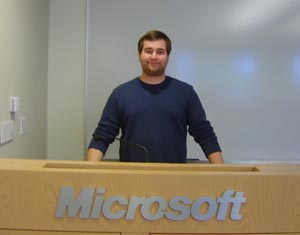 Bill Rainford (CAS/GRS’04) knew Microsoft would be a good fit for him after he graduated from BU, and the Computer Science Department helped him get there. “I wanted to work at a company where I could be at the forefront of new technologies,” Rainford says. Today, as a Software Design Engineer in Test (SDET) for Microsoft, he’s doing just that—working on the next generation of Windows CE/Windows Mobile embedded devices, including Smart Phones, Pocket PCs, and portable media centers and players.Rainford’s interest in computer science has evolved over time, from a love for computers and gadgets as a child, to Web page consulting in high school, to building Web pages for BU’s History Department, to working as a software developer for NYFIX, Inc., where his interest in database systems, the focal point of his graduate research, first peaked. “The more I worked with computers, the more I wanted to take in-depth classes on the subject,” he says.
Bill Rainford (CAS/GRS’04) knew Microsoft would be a good fit for him after he graduated from BU, and the Computer Science Department helped him get there. “I wanted to work at a company where I could be at the forefront of new technologies,” Rainford says. Today, as a Software Design Engineer in Test (SDET) for Microsoft, he’s doing just that—working on the next generation of Windows CE/Windows Mobile embedded devices, including Smart Phones, Pocket PCs, and portable media centers and players.Rainford’s interest in computer science has evolved over time, from a love for computers and gadgets as a child, to Web page consulting in high school, to building Web pages for BU’s History Department, to working as a software developer for NYFIX, Inc., where his interest in database systems, the focal point of his graduate research, first peaked. “The more I worked with computers, the more I wanted to take in-depth classes on the subject,” he says.
During his junior year at BU, Rainford was accepted into a special program offered by the Computer Science Department for a BA/MA, a joint degree students can earn in four and a half years after completing graduate course work and a master’s project in addition to the standard BA requirements.
Before joining Microsoft, Rainford was a student consultant for the company on BU’s campus and a student member of the Institute of Electrical and Electronics Engineers. Now a part of Microsoft’s Mobile and Embedded Devices Division, he’s working toward the next step in his career, becoming a SDET team lead, and looks back on his experience with computer science at BU as a springboard for his success today.
“The Computer Science Department and BU provided a lot of opportunities for me to meet and network with some of the top people in business,” Rainford says. “A combination of applied computer science classes, a desire to learn, and my work experience as an undergraduate helped me get where I am today.”
Ori Schwartz, Fleaflicker, CAS’03
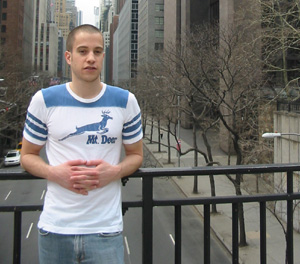 After earning a joint degree in computer science and mathematics at BU, together with a BA in economics, Ori Schwartz (CAS’03) found the perfect way to combine his love for computers with another passion—football—by launching Fleaflicker.com, a free, ad-supported online fantasy football service. The popularity of fantasy football “exploded” in the 1990s with the rise of the Internet, Schwartz says, and football now attracts over 12 million fantasy players annually. He explains the game as one based on statistics, where users develop imaginary teams comprised of professional football players; these teams then compete against each other based on the players’ real-life statistics. “I’ve always been a football fan,” Schwartz says, “and over the years I tried nearly all of the major online services. My friends and I paid for what was supposedly a premium service, but we were ultimately disappointed. I thought I could do better.” Schwartz launched Fleaflicker in August 2005 after 10 months of initial development, and since received praise from users who had grown dissatisfied with other big-name services. The continued growth of Fleaflicker after its launch in 2005 has since attracted the attention of America Online (AOL), which bought the site from Schwartz in April 2008 after expressing interest as early as 2007. “I was very happy working on Fleaflicker independently,” Schwartz says, “but I also thought I had taken the site as far as I could alone, and it was time to expand aggressively.” While the site is under new ownership, Schwartz continues to lead its development, both from home and from his office in the new AOL building on Broadway in New York City. He says the many different technologies incorporated into the site would’ve been impossible to apply without his computer science degree, and he’s always looking for new and innovative ways to expand the service. ” I still think there are a lot of cool things we can do with Fleaflicker,” he says. “I’m very happy working on it.”
After earning a joint degree in computer science and mathematics at BU, together with a BA in economics, Ori Schwartz (CAS’03) found the perfect way to combine his love for computers with another passion—football—by launching Fleaflicker.com, a free, ad-supported online fantasy football service. The popularity of fantasy football “exploded” in the 1990s with the rise of the Internet, Schwartz says, and football now attracts over 12 million fantasy players annually. He explains the game as one based on statistics, where users develop imaginary teams comprised of professional football players; these teams then compete against each other based on the players’ real-life statistics. “I’ve always been a football fan,” Schwartz says, “and over the years I tried nearly all of the major online services. My friends and I paid for what was supposedly a premium service, but we were ultimately disappointed. I thought I could do better.” Schwartz launched Fleaflicker in August 2005 after 10 months of initial development, and since received praise from users who had grown dissatisfied with other big-name services. The continued growth of Fleaflicker after its launch in 2005 has since attracted the attention of America Online (AOL), which bought the site from Schwartz in April 2008 after expressing interest as early as 2007. “I was very happy working on Fleaflicker independently,” Schwartz says, “but I also thought I had taken the site as far as I could alone, and it was time to expand aggressively.” While the site is under new ownership, Schwartz continues to lead its development, both from home and from his office in the new AOL building on Broadway in New York City. He says the many different technologies incorporated into the site would’ve been impossible to apply without his computer science degree, and he’s always looking for new and innovative ways to expand the service. ” I still think there are a lot of cool things we can do with Fleaflicker,” he says. “I’m very happy working on it.”
Maria Shugrina, Google, CAS’07
 It didn’t take long for Maria Shugrina (CAS’07), after hearing that animated movies like Shrek relied heavily on computer science, to decide that it would be an ideal course of study for her. “I tried it, liked it, and decided to major in it,” she says. Her initial curiosity at BU about computer graphics led to a fascination with many different areas of the computer science field, including computer vision; during a summer internship with the University of Bath in the UK, Shugrina collaborated on a research project that enabled users to manipulate the rendering of an impasto oil painting with their facial expressions, captured with a webcam. “What makes computer science exciting, and what makes it one of the best fields to pursue, is the range of problems that it can solve,” she says. As a software engineer for Google, working on Web interface development and programming in a range of languages, Shugrina is exploring some of the many applications of her major, and she says “the freedom to do both research and engineering is a great thing to have.” On Google’s speech team, she is “developing computer systems that involve automatically transcribing spoken content”; she is participating in the Goog411 project, “a free, fully automated 411 service”; and she is part of Google’s speech indexing team, which, she explains, “involves indexing automatically generated transcriptions for search.” The most rewarding part of her job, she says, is “the opportunity to make a direct impact on the lives of people.” The “breadth of experience” Shugrina says she gained at BU-clearly reflected in her role at Google-is a common thread in her career path. She thanks her adviser, Margrit Betke, among others, for helping her to take full advantage of the program’s offerings. “There are many excellent professors and courses at BU,” she says, and “the Computer Science Department provides great opportunities for gaining a well-rounded knowledge of the field.”
It didn’t take long for Maria Shugrina (CAS’07), after hearing that animated movies like Shrek relied heavily on computer science, to decide that it would be an ideal course of study for her. “I tried it, liked it, and decided to major in it,” she says. Her initial curiosity at BU about computer graphics led to a fascination with many different areas of the computer science field, including computer vision; during a summer internship with the University of Bath in the UK, Shugrina collaborated on a research project that enabled users to manipulate the rendering of an impasto oil painting with their facial expressions, captured with a webcam. “What makes computer science exciting, and what makes it one of the best fields to pursue, is the range of problems that it can solve,” she says. As a software engineer for Google, working on Web interface development and programming in a range of languages, Shugrina is exploring some of the many applications of her major, and she says “the freedom to do both research and engineering is a great thing to have.” On Google’s speech team, she is “developing computer systems that involve automatically transcribing spoken content”; she is participating in the Goog411 project, “a free, fully automated 411 service”; and she is part of Google’s speech indexing team, which, she explains, “involves indexing automatically generated transcriptions for search.” The most rewarding part of her job, she says, is “the opportunity to make a direct impact on the lives of people.” The “breadth of experience” Shugrina says she gained at BU-clearly reflected in her role at Google-is a common thread in her career path. She thanks her adviser, Margrit Betke, among others, for helping her to take full advantage of the program’s offerings. “There are many excellent professors and courses at BU,” she says, and “the Computer Science Department provides great opportunities for gaining a well-rounded knowledge of the field.”
Kenda Stewart, Goodwin Proctor, LLP, CAS’03
 Attorney Kenda Stewart (CAS’03) is applying her computer science experience in ways she never thought possible. After double majoring in computer science and political science at BU, Stewart earned a law degree at Cornell University in 2006 before joining Goodwin Procter LLP in Boston. “A major in computer science is extremely applicable to law school,” she says. “Drafting a law contract is very similar to programming. It requires the same sort of logical planning and thinking and the defining of variables.” Today, she works in the Intellectual Property Transactions and Strategies Practice Area of Goodwin Procter LLP. “I enjoy learning about our clients’ business models and new products and ideas,” she says, “and it’s rewarding to play a role in getting some very cutting-edge software and technology out on the market.” Stewart says she also enjoys working with clients on license agreements and transactions within the software space and contributing to the dialogue on defining intellectual property rights. “With the increase and proliferation of the Internet and software technology, the protection and acquisition of intellectual property is becoming a primary concern in almost every industry,” she explains. At BU, where Stewart was first introduced to programming and compiling in the Computer Science Department, two classes made a lasting impression—Fundamentals of Computing Systems with Professor Azer Bestavros and Computer Networks with Associate Professor John Byers—and the basic fundamentals she acquired from the program continue to resonate in the interdisciplinary work she does today. “The computer science program at BU is really about teaching you how to think,” Stewart says. “Programming languages become obsolete every year, so the knowledge you take with you is the knowledge of how to think logically, problem solve, and apply elements to rules. These skills are useful in every aspect of life, and they have been very useful to me in my practice of law.”
Attorney Kenda Stewart (CAS’03) is applying her computer science experience in ways she never thought possible. After double majoring in computer science and political science at BU, Stewart earned a law degree at Cornell University in 2006 before joining Goodwin Procter LLP in Boston. “A major in computer science is extremely applicable to law school,” she says. “Drafting a law contract is very similar to programming. It requires the same sort of logical planning and thinking and the defining of variables.” Today, she works in the Intellectual Property Transactions and Strategies Practice Area of Goodwin Procter LLP. “I enjoy learning about our clients’ business models and new products and ideas,” she says, “and it’s rewarding to play a role in getting some very cutting-edge software and technology out on the market.” Stewart says she also enjoys working with clients on license agreements and transactions within the software space and contributing to the dialogue on defining intellectual property rights. “With the increase and proliferation of the Internet and software technology, the protection and acquisition of intellectual property is becoming a primary concern in almost every industry,” she explains. At BU, where Stewart was first introduced to programming and compiling in the Computer Science Department, two classes made a lasting impression—Fundamentals of Computing Systems with Professor Azer Bestavros and Computer Networks with Associate Professor John Byers—and the basic fundamentals she acquired from the program continue to resonate in the interdisciplinary work she does today. “The computer science program at BU is really about teaching you how to think,” Stewart says. “Programming languages become obsolete every year, so the knowledge you take with you is the knowledge of how to think logically, problem solve, and apply elements to rules. These skills are useful in every aspect of life, and they have been very useful to me in my practice of law.”
Jason Terk, CoreStreet, CAS’05
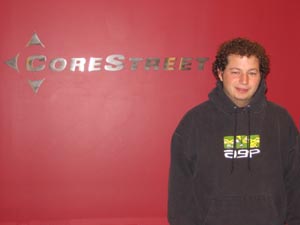 “I’ve always been interested in computers, how they work, how to make them do new things,” says Jason Terk (CAS’05), who took his interest to the next level as an undergraduate in BU’s Computer Science Department before signing on as a full-time software engineer for CoreStreet. A top provider of products and solutions for identity management and access control, Corestreet enables companies to securely control the physical and logical access of their buildings, computer networks, applications, and devices.At Corestreet, Terk works on Public Key Infrastructure (PKI) products, which implement certificate validation technology designed to authenticate the credentials of anyone attempting to interact with secure IT applications, including digitally signed e-mail and secure forms employed by the U.S. Department of Defense and other security conscious organizations worldwide.
“I’ve always been interested in computers, how they work, how to make them do new things,” says Jason Terk (CAS’05), who took his interest to the next level as an undergraduate in BU’s Computer Science Department before signing on as a full-time software engineer for CoreStreet. A top provider of products and solutions for identity management and access control, Corestreet enables companies to securely control the physical and logical access of their buildings, computer networks, applications, and devices.At Corestreet, Terk works on Public Key Infrastructure (PKI) products, which implement certificate validation technology designed to authenticate the credentials of anyone attempting to interact with secure IT applications, including digitally signed e-mail and secure forms employed by the U.S. Department of Defense and other security conscious organizations worldwide.
“I know that the products I work on will help to bring good security practices and good technology to regular people,” Terk says. “As our products become accepted by more corporations and other organizations, there will be an increased demand for accountability and security on the Internet, which is a good thing for all involved.”
Terk chose to channel his growing fascination with computers at BU, he says, because of the professors, the program, and the liberal arts curriculum. But it was a specific course that gave him the reassurance he was looking for in the field. Through Cryptography, Terk admits, he developed an appreciation for the theoretical aspects of computer science, which, he says, “allow me to comprehensively think about the problems I face working with computers.”
“BU offers a great computer science program with excellent professors who are at the forefront of research in the field,” Terk says. “Because of the education I received at BU, I have experience with all aspects of computer science, not just a superficial understanding of a handful of programming languages of the day or the latest piece of software.”
Mikhail Urinson, Siemens AG, CAS’03
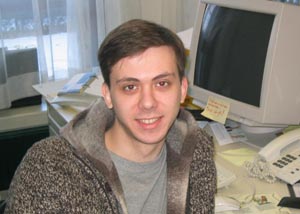 Mikhail Urinson (CAS ’03), a software engineer for Siemens AG in Graz, Austria, says he was very lucky to find a position with such a prestigious company. “The job I’ve found is pretty much perfect for me,” he says. But a closer look reveals that talent, perseverance, and a strong background in computer science—not luck—secured Urinson his dream job. “A good technical education allows you to choose from many career options, and to go wherever you want,” he says.Urinson was inspired to look for work abroad after attending the eighth ERCIM Workshop, “User Interfaces for All,” in Vienna in 2004 with a fellow classmate and professor from BU. Urinson presented a paper written by the trio, titled “A Method to Extend Functionality of Pointer Input Devices,” which stemmed from a directed study he completed on gesture recognition and human-computer interfaces for the physically disabled.
Mikhail Urinson (CAS ’03), a software engineer for Siemens AG in Graz, Austria, says he was very lucky to find a position with such a prestigious company. “The job I’ve found is pretty much perfect for me,” he says. But a closer look reveals that talent, perseverance, and a strong background in computer science—not luck—secured Urinson his dream job. “A good technical education allows you to choose from many career options, and to go wherever you want,” he says.Urinson was inspired to look for work abroad after attending the eighth ERCIM Workshop, “User Interfaces for All,” in Vienna in 2004 with a fellow classmate and professor from BU. Urinson presented a paper written by the trio, titled “A Method to Extend Functionality of Pointer Input Devices,” which stemmed from a directed study he completed on gesture recognition and human-computer interfaces for the physically disabled.
Computer graphics courses offered through the Computer Science Department encouraged Urinson to pursue his first directed study; this project required him to write a program that employed a sophisticated rendering algorithm based on a photon mapping technique. “I consider this project one of my biggest achievements,” he says.
A job with Siemens, one of the world’s largest electrical engineering and electronics companies, supplying innovative technologies worldwide, satisfied Urinson’s professional expectations, while also allowing him to be closer to his family and friends in his native hometown of Moscow. “I am very happy that I can learn new technologies and immediately use them in actual products,” he says.
After graduating from BU, Urinson went on to earn a master’s degree at Tufts University, and his graduate research project focused on applying image analysis to medical data. Choosing to double major in computer science and math at BU, Urinson adds, was “the best decision of my life. It allows me to do interesting and rewarding work, and to apply my creative and analytical thinking in the best way I can.”
Jenn Wortman, University of Pennsylvania, CAS ’02
 Jenn Wortman (CAS ’02), a PhD candidate in the Department of Computer and Information Science at the University of Pennsylvania, says she routinely draws upon the skills she learned as an undergraduate at BU as she pursues her graduate studies. “The courses I took at BU taught me fundamental math and reasoning skills that serve as a foundation for everything I do today,” she says.
Jenn Wortman (CAS ’02), a PhD candidate in the Department of Computer and Information Science at the University of Pennsylvania, says she routinely draws upon the skills she learned as an undergraduate at BU as she pursues her graduate studies. “The courses I took at BU taught me fundamental math and reasoning skills that serve as a foundation for everything I do today,” she says.
At Penn, Wortman’s research focuses on artificial intelligence and machine learning, interests she developed at Stanford University, where she earned her master’s degree in computer science, with a specialization in artificial intelligence, in 2004.
Machine learning, Wortman explains, “generally involves training adaptive algorithms or systems to use past experience or data in order to make predictions on new unseen data,” and can be applied to areas like search engine design, stock market analysis, speech and handwriting recognition, robotics, computer vision, and DNA sequence analysis.
Wortman says she knew she wanted to pursue computer science after taking advanced placement (AP) programming classes in high school, and has always enjoyed math and solving problems. She credits courses offered by the Computer Science Department at BU, like Image and Video Computing and Advanced Computer Graphics, for giving her a “first taste of what research might be like. I was finally able to fully incorporate my mathematical training into the work I was doing,” she says.
Today, Wortman is a teaching assistant at Penn for an undergraduate course on network theory, and last year assisted a graduate-level introduction to artificial intelligence. She says she hopes to join the faculty of a research-oriented university after earning her PhD, but has never been one to limit herself. “My goals and interests have shifted over the past few years and are still evolving now,” she says, “but I’ve always been able to pick up new skills and knowledge thanks to the solid background my undergraduate studies gave me.”
MA & Phd Alumni
Paul Barford, University of Wisconsin-Madison, GRS ’00
 Paul Barford (GRS ’00) majored in electrical engineering at the University of Illinois, and worked in the industry for eight years after earning his BS in 1985, but the lure of the Internet boom in the 1990s and its impact on computer science was irresistible. “I was captivated by the idea of an infrastructure that enables hundreds of millions of people to communicate and exchange information,” he says.
Paul Barford (GRS ’00) majored in electrical engineering at the University of Illinois, and worked in the industry for eight years after earning his BS in 1985, but the lure of the Internet boom in the 1990s and its impact on computer science was irresistible. “I was captivated by the idea of an infrastructure that enables hundreds of millions of people to communicate and exchange information,” he says.
Intrigued by computer science, Barford was ready to pursue graduate work in the field. “It was clear in 1994 and 1995 that BU was doing pioneering studies on the Internet,” he says, “and I was eager to become active in that area.” At BU, Barford collaborated with his adviser in the department on projects that developed into the principle components of his dissertation and resulted in eight published papers.
Barford’s dissertation focused on “developing a detailed empirical understanding of how the Web works in real life.” He also recalls his participation in a research group at the university, known today as the Web and InterNetworking Group (WING), where students and faculty work closely together. “I learned how to be a researcher while I was there,” he says, “and am proud to have been part of that group.”
An assistant professor in the Department of Computer Sciences at the University of Wisconsin-Madison since 2001, Barford “revamped the curriculum,” has taught both the introductory and advanced networking courses, and recently designed a new course, Network Systems Laboratory.
Barford says he is interested in “understanding the details of how the Internet is structured and how it behaves,” and develops tools that allow for an unprecedented glimpse into the inner workings of the infrastructure, especially those that identify and block the “malicious activity” of hackers and identity thieves. He wouldn’t be where he is today, he adds, without “all aspects” of his education at BU. “I received the best training possible from the Computer Science Department,” he says.
Elena Machkasova, University of Minnesota, Morris, GRS ’02
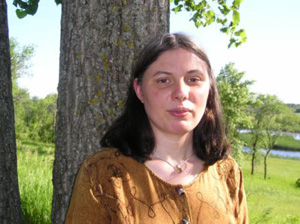 After completing a five-year program in applied mathematics in her native Russia, Elena Machkasova (GRS ’02) traveled some 5,000 miles to the East Coast of the United States, studied computer science for a semester at the University of Southern Maine, and decided to pursue a PhD at BU in 1996, all the while adapting to a foreign culture, learning a second language, and raising her young son Yuri, and later a second son, Lenny.
After completing a five-year program in applied mathematics in her native Russia, Elena Machkasova (GRS ’02) traveled some 5,000 miles to the East Coast of the United States, studied computer science for a semester at the University of Southern Maine, and decided to pursue a PhD at BU in 1996, all the while adapting to a foreign culture, learning a second language, and raising her young son Yuri, and later a second son, Lenny.
Machkasova says she wanted to work toward a PhD in Computer Science at BU because of the research opportunities in programming languages offered by the department, and because she could also work as a Teaching Fellow. “My research experience at BU has been extremely helpful,” Machkasova says. Her participation in the Church Project, a research group founded by the Computer Science Department at BU, named after the late Alonzo Church, as well as the advice she received from BU professors, enabled her to excel in the field.
During her last year at BU, Machkasova was an instructor of Science Laboratory at Wellesley College and in 2002 developed and taught her own course there, Introduction to E-commerce. She joined the faculty at the University of Minnesota, Morris, where she is an assistant professor in the Division of Science and Math, in 2003. Machkasova has taught many courses over her three years on the faculty, including Data Structures, Web Programming, Software Design and Development, and Cryptographic Protocols.
“I really enjoy the active involvement of students in all aspects of academic life,” Machkasova says. She has worked on a number of projects with students, the results of which were published as student papers at the Midwest Instructional and Computing Symposium in 2005 and 2006.
“The most rewarding and most challenging part of my job is keeping up-to-date with the recent developments in theoretical and practical aspects of computer science and incorporating them into courses and research,” Machkasova says. But perhaps not nearly as challenging, she admits, as “finishing a PhD and continuing to work in academia while raising two children. I call that a fairly impressive accomplishment.”
Kihong Park, Purdue University, GRS ’96
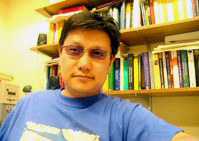 Kihong Park (GRS ’96), an associate professor in the Department of Computer Sciences at Purdue University, says he enjoys all the freedoms that academic life has to offer, and that he was pleasantly surprised to find, once he joined the doctoral program at BU, that graduate students were given an unprecedented amount of independence, which allowed them to think, explore, and discover on their own.
Kihong Park (GRS ’96), an associate professor in the Department of Computer Sciences at Purdue University, says he enjoys all the freedoms that academic life has to offer, and that he was pleasantly surprised to find, once he joined the doctoral program at BU, that graduate students were given an unprecedented amount of independence, which allowed them to think, explore, and discover on their own.
Park earned a BA from Seoul National University in the School of Management and a MS in computer science from the University of South Carolina in 1990. He says he chose to continue his graduate studies at BU because the Computer Science faculty included top theoreticians in cellular automata and Kolmogorov complexity, his areas of interest at the time. Park’s dissertation at BU focused on cellular automata, “parallel computing machines” invented by John von Neumann.
At Purdue, Park’s research involves the theory and practice of computer networks and communication, network security, and fault-tolerant distributed computing, and he teaches courses in networks and distributed systems. “I am interested in how large-scale distributed systems behave,” Park says. He points to particle systems in physics, cellular biology, neural networks, social networks, and distributed computing systems as “examples of massive distributed systems whose hidden secrets we seek to understand.”
Park participated in two important developments in science that originated from the field of computer networks: the fractal nature of Internet traffic and the power-law connectivity of computer networks. “The repercussions of these distributed systems discoveries have been great, extending to physics, mathematics, biology, and social sciences,” he says.
“It was a bastion of intellectual freedom,” Park remembers of BU, “not in overabundance today at graduate schools, especially in computer science.” Today, Park is enjoying the same autonomy as a tenured professor at Purdue that he valued as a graduate student at BU. This freedom to think and explore in academia, he adds, makes the United States, what he calls the “mecca of scientific innovation in the world, a great place for professional thinkers.”
Santiago Pericas-Geertsen, Sun Microsystems, GRS ’99, ’01
 Santiago Pericas-Geertsen (GRS ’99, ’01) says he was attracted to the Boston area—home to over 200,000 students—because the city is “such a hub” for computer scientists. And as soon as he decided to pursue graduate study at BU, all of the pieces fell into place: he joined the Church Project, developed Espresso, a compiler for the Java language, and interned with Sun Microsystems, where he now works as a staff engineer.
Santiago Pericas-Geertsen (GRS ’99, ’01) says he was attracted to the Boston area—home to over 200,000 students—because the city is “such a hub” for computer scientists. And as soon as he decided to pursue graduate study at BU, all of the pieces fell into place: he joined the Church Project, developed Espresso, a compiler for the Java language, and interned with Sun Microsystems, where he now works as a staff engineer.
After studying computer engineering at the Technology Institute of Buenos Aires, Pericas-Geertsen concentrated on the theory of programming languages at BU, where he also taught undergraduate and graduate courses. He developed Espresso, together with a fellow student and supervising professor, while working toward his master’s degree. “My involvement with this project was the primary reason why Sun Microsystems contacted me for the internship,” he says.
During his internship with Sun in Burlington, Massachusetts, in 2000, Pericas-Geertsen participated in a two-person project to create the first compiler for the XSLT language. The compiler, he says, is now part of Sun’s Java Runtime System version 1.5, “which is available in thousands, if not millions, of computers around the world.”
The Church Project, Pericas-Geertsen explains, was one of the main reasons he decided to continue on as a PhD candidate at BU, and says the hands-on experience he gained building language tools was “instrumental” for his professional career. Named after the late Alonzo Church, inventor of the lambda calculus, the project investigates the foundations, design principles, and implementation techniques of programming languages and related systems.
Pericas-Geertsen now works full time from home in Florida for Sun, where he is the technical lead of the Web Services Performance group in the Java Web Services organization, and says BU graduates are “very well regarded within the company.” Someday, he adds, he would like to found or join a startup company in its early stages. “The excitement of seeing a company develop from where there was no company before is really appealing to me,” he says.
Maj. Benjamin Ring, U.S. Military Academy at West Point, GRS ’06
 One of the many courses Maj. Benjamin Ring (GRS ’06) teaches at the United States Military Academy (USMA) at West Point is computer graphics—an area he was first introduced to as a graduate student in the computer science program at BU. “I found a passion in graphics and imaging, and I truly enjoy working in those topics,” he says.
One of the many courses Maj. Benjamin Ring (GRS ’06) teaches at the United States Military Academy (USMA) at West Point is computer graphics—an area he was first introduced to as a graduate student in the computer science program at BU. “I found a passion in graphics and imaging, and I truly enjoy working in those topics,” he says.
Major Ring credits BU not only for his initial discovery of computer graphics, but also for enabling him to complete a master’s degree in less than two years, which played an integral role in his career path. After returning in 2005 from his deployment in Iraq—for which he earned a Bronze Star—Major Ring was selected to serve as an instructor in the Department of Electrical Engineering and Computer Science at USMA.
But upon his return, he was held with his unit at Fort Hood, Texas, for an additional six months, and so the ability to complete his master’s degree in eighteen months, before starting his new teaching post, was key. BU also helped Major Ring bridge the eight-year gap he faced in academia since earning his BA at USMA in 1996 and serving in the army (he deployed to Bosnia in ’97 and to Kosovo in ’99).
Today, Major Ring has made quite an imprint at USMA, where he is now an assistant professor and a senior research scientist at the Information Technology Operations Center (ITOC). He is also head coach of the West Point Judo Team and recently advised an undergraduate team that won first place at the RIT IEEE Eighth Annual Student Design Contest.
With twelve years already dedicated to the army, Major Ring anticipates serving for another eight years within the computer science field. “After that, I can possibly see myself staying in the army and perhaps returning to the faculty at USMA,” he says, “or retiring from the army and starting a new career back in the Boston area-the region I will always want to return to.”
Romer Rosales, Siemens Medical, GRS ’99, ’02
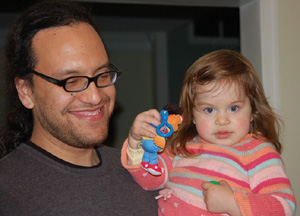 Scientist Romer Rosales (GRS ’99, ’02) says he hopes to explore the world of applied research for some time, as it plays a vital role in his efforts to improve medical technology and services for Siemens Medical Solutions USA. But it was the possibility of research freedom, and the potential to explore a number of research topics, that first attracted him to graduate study in computer science at BU.
Scientist Romer Rosales (GRS ’99, ’02) says he hopes to explore the world of applied research for some time, as it plays a vital role in his efforts to improve medical technology and services for Siemens Medical Solutions USA. But it was the possibility of research freedom, and the potential to explore a number of research topics, that first attracted him to graduate study in computer science at BU.
“Once at BU,” Rosales explains, “I found a well-established theoretical computer science program and a rapidly emerging research program in more applied areas that included computer networks and machine vision.” For Rosales, the unique autonomy he discovered among students at BU made the university stand out in Boston, what he calls a “key center for computer science research.”
Rosales pursued artificial intelligence and computer vision and participated in the Image and Video Computing (IVC) group, which is developing systems to determine what a computer “sees” or “recognizes.” After earning his MA in computer science, he wasted no time conducting research for his PhD. Rosales says his dissertation “introduced a method for understanding 3D structures, in terms of their geometrical configuration, from images.”
When Rosales finished his PhD, he focused on machine learning research, working as a postdoctoral fellow at the University of Toronto and later at MIT. “I worked on problems related to probabilistic interference,” he says. “My research included applied areas such as image processing, data clustering, gene expression analysis, and more basic research problems such as devising approximate methods for approaching computationally intractable problems related to probabilistic interference.”
Within Siemens Medical, Rosales works in a group called Computer-Aided Diagnosis and Therapy, a rather independent, small group dedicated to discovering new means for automatizing tasks in the field of medicine in general.” Rosales says he enjoys the work not only because he uses his knowledge to develop technology that will improve the health of others, but also because “research and innovation is given high priority,” and in groups this small in size, the contributions of each individual can have a significant overall effect in the organization.
Jing Zhong, Amicas, GRS ’04
 Before deciding to pursue a master’s degree in computer science at BU, Jing Zhong (GRS ’04) did her homework: she spoke with professors, learned more about the computer vision program at the university, and took notice of the department, the academic environment, and the research opportunities available to students. Zhong liked what she saw, and says the Image and Video Computing (IVC) group,” which is developing systems to determine what a computer “sees” or “recognizes,” was a deciding factor.
Before deciding to pursue a master’s degree in computer science at BU, Jing Zhong (GRS ’04) did her homework: she spoke with professors, learned more about the computer vision program at the university, and took notice of the department, the academic environment, and the research opportunities available to students. Zhong liked what she saw, and says the Image and Video Computing (IVC) group,” which is developing systems to determine what a computer “sees” or “recognizes,” was a deciding factor.
“I was very impressed by both the projects conducted by the IVC group and the research passion of its members,” she says. Zhong had already earned an MS in computer vision from the National University of Singapore, and she was no stranger to research. Before arriving in Boston, Zhong published four papers related to her field in international conferences.
Zhong’s success continued at BU, where she completed several research projects in the computer vision laboratory; her thesis focused on detecting foreground objects from complex dynamic backgrounds. “I learned a lot by doing these projects, and significantly improved my technical skills, communication skills, and independent research capability,” she says.
A paper related to her area of interest, “Segmenting foreground objects from a dynamic textured background via a robust Kalman filter,” was published in the Proceedings of the International Conference on Computer Vision in 2003. After graduating from BU, Zhong worked for Financial Labs, LLC. In September 2004, she joined Amicas, a company that provides radiology and medical image and information management solutions to community hospitals and imaging centers.
Zhong is currently developing the server for Amicas, Web-based Picture Archiving and Communication System (PACS), which helps health care systems transfer over to a filmless environment and gives medical professionals immediate access to a patient’s current and prior studies. “The most rewarding part of my job is that I can apply the technical skills that I gained at BU to the development of an actual product that is impacting people in real life,” Zhong says.
All profiles written by Abby Collier (GRS ’05) and Szu Yu Chen.